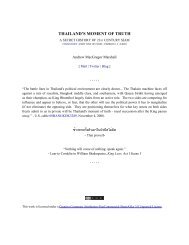THAILAND'S MOMENT OF TRUTH - ZENJOURNALIST
THAILAND'S MOMENT OF TRUTH - ZENJOURNALIST
THAILAND'S MOMENT OF TRUTH - ZENJOURNALIST
You also want an ePaper? Increase the reach of your titles
YUMPU automatically turns print PDFs into web optimized ePapers that Google loves.
“A PERIOD <strong>OF</strong> CONFUSION AND WILD INTRIGUE”<br />
The most momentous event in the history of the Chakri dynasty since the 1932 revolution that<br />
stripped the monarchy of absolute power unfolded quite unexpectedly shortly before dusk<br />
on Sunday, September 19, 2010, in the middle of a Bangkok traffic intersection surrounded<br />
by luxury malls and five star hotels and haunted by restless spirits. It was over within a few<br />
minutes, and many Thais remain unaware that it ever happened at all.<br />
It was four years to the day since royalist generals had seized power in a coup that snuffed out<br />
the precious embers of political progress so many Thais had risked their lives for in the Black<br />
May battles of 1992, and four months to the day since the military had crushed another mass<br />
pro-democracy rally in downtown Bangkok, storming the fortified encampment occupied<br />
by thousands of Red Shirt protesters who had blockaded the Ratchaprasong intersection for<br />
weeks to demand new elections.<br />
If Ratchadamnoen represents the heart of old Bangkok, Ratchaprasong is the symbolic centre<br />
of the modern capital. As Benedict Anderson wrote in Withdrawal Symptoms:<br />
As late as 1960, Bangkok could still be described as the “Venice of the East”, a<br />
somnolent old-style royal harbour-city dominated by canals, temples and palaces.<br />
Fifteen years later, many of the canals had been filled in to form roads and many<br />
of the temples had fallen into decay. The whole centre of gravity of the capital had<br />
moved eastwards, away from the royal compounds and Chinese ghettoes by the Chao<br />
Phraya river to a new cosmopolitan zone dominated visually and politically by vast<br />
office buildings, banks, hotels and shopping plazas.<br />
Ratchaprasong is a hectic traffic junction about two and a half miles east of the old royal<br />
quarter. On the northwest corner is the vast Central World Plaza shopping, cinema and tenpin<br />
bowling megaplex, which boasts of being among the biggest malls in the world. On<br />
the northeast side are two more giant malls: Gaysorn Plaza, which lays claim to the title of<br />
Bangkok’s most upscale designer shopping destination, and the strangely shaped hulk of<br />
the Big C superstore. Just to the north of this consumer paradise is the Klong Saen Saab, the<br />
canal of ten thousand mosquito stings, one of Bangkok’s remaining working waterways that<br />
cuts a fetid path through the city all the way from the Chao Phraya river in the west to the<br />
eastern suburbs and beyond; it is the fastest way to get from the old Bangkok to the new. Two<br />
more huge buildings dominate the south side of the Ratchaprasong intersection: the police<br />
hospital on the southwest corner, and on the southeast the 380 room Grand Hyatt Erawan<br />
hotel, a 22-storey tower rising from greying faux-neoclassical columns. In its shadow, on<br />
the corner of the junction, is the Erawan shrine, dedicated to the Hindu creation god Brahma<br />
and built in 1956 to appease the bad karma unleashed by construction work in the area.<br />
At the centre of the shrine, a four-faced gilded statue of Brahma sits inside a spirit house;<br />
the enclosure is draped with hundreds of flower garlands left as offerings. Peddlers on the<br />
sidewalk hawk small birds in wooden cages, offering visitors to the shrine a conveniently<br />
easy way to do a good deed and gain some merit by paying to release them. Overhead, the<br />
two lines of the mass transit Skytrain system converge in a brutalist concrete thicket, blocking<br />
out the sun.<br />
The violent struggle that convulsed the Thai capital in April and May 2010 began in the old<br />
quarter, already haunted by the uncounted ghosts of the dead from past political violence.<br />
The killing started on the evening of April 10 after Thai soldiers launched an operation to<br />
clear Red Shirt protesters occupying the Phan Fa bridge, scene of so many past battles in<br />
Thailand’s bloody political history. The commander of the operation was assassinated in<br />
2




